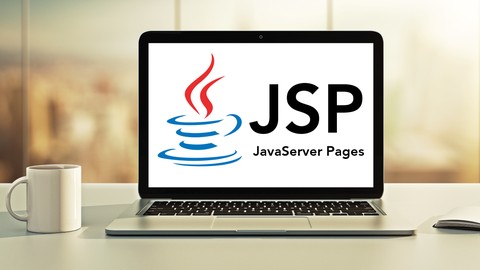Top Java EE Video Tutorials (Servlet, JSP, JSF and Web Services)
- Details
- Written by Nam Ha Minh
- Last Updated on 20 April 2016 | Print Email
Java EE development is very popular in the Java programming world. Empowering yourself with Java EE expertise will give you very good career opportunities. To master Java EE quickly and efficiently, we recommend you to take specialized courses which are listed below:
- Servlets and JSPs Tutorial: Learn Web Applications With Java
- JSP and Servlets for Beginners: Build a Database Web App
- JSF - Java Server Faces for Beginners - Build a Database App
- Java Web Services
1. Servlets and JSPs Tutorial: Learn Web Applications With Java
This course helps you learn how to create dynamic websites using the Java programming language with Servlet and JSP technologies.
In this Java web application tutorial course you'll learn how to:
- Leverage the power of Java to create dynamic websites
- Deploy your applications for free on the Internet
- Use and understand core server-side Java web technologies
The instructor will show you how to take your basic Java knowledge and use it to create websites using the same technologies (servlets, JSPs and JSTL) that everyone from self-employed web developers to huge corporations use to create modern interactive web sites.
What am I going to get from this course?
- Over 64 lectures and 10 hours of content!
- Understand the core technologies of modern Java web programming
- Know how to develop and deploy your own websites using Java
Here’s the curriculum of this course:
- Section 1: Setting up development environment and creating a hello world application
+ Setting up the system
+ Creating a hello world servlet.
+ Creating a hello world JSP page.
+ Deployment descriptors file web.xml
+ Deploying your application to a local server and to the Internet
- Section 2: Fudamentals of JSP and Servlet
+ Getting URL parameters; Including files; Forwarding and redirecting.
+ The declaration tag; JSP tags summary.
+ Model 1 vs. Model 2 architecture
+ The Servlet Lifecycle
- Section 3: Beans and Forms
+ JSP Beans; Beans scope; Setting Bean properties using parameters.
+ Forms; HTTP Posts.
+ Using beans to store form data; Adding validation to beans.
+ Self-validating forms; Validating forms using MVC architecture.
- Section 4: Sessions and Cookies
+ The Session object; URL rewriting;
+ The ServletContext object; Getting initialization parameters from web.xml
+ Scoped Objects; Cookies
- Section 5: Databases
+ Connecting to a database; Querying databases; Inserting into databases.
+ Setting up JNDI Data Source
- Section 6: Sending emails
- Section 7: JSP Standard Tag Library (JSTL)
Take the Servlets and JSPs Tutorial: Learn Web Applications With Java Course
2. JSP and Servlets for Beginners: Build a Database Web App
This course helps you learn how to build a Java database web application with JSPs and Servlet ... all from scratch. The course is appropriate for all Java developers: beginners to advanced.
This course has received rave 5 star reviews and over 30,000 students have taken the course. Also, it is one of the most popular courses in their respective categories.
Benefits of Taking This JSP/Servlets Course:
Knowing JSP and Servlets can get you a job or improve the one you have. It's a skill that will put you more in demand in the modern web development industry, and make your software life easier, that's why it's so popular and backed by Oracle.
This course will help you quickly get up to speed with JSP and Servlets. We will demystify the technology and help you understand the essential concepts to build a real JSP/Servlet web application from scratch.
You Will Learn How To:
- Build a fully functioning JSP/Servlet web application from scratch
- Set up your JSP/Servlet development environment with Tomcat and Eclipse
- Explore JSP scripting elements: Expressions, Scriptlets and Declarations
- Read HTML form data with JSP and Servlets
- Include additional files in your JSP file for a standard look-and-feel
- Manage application state with Sessions to track unique user actions
- Leverage Cookies to personalize a web site for a specific user
- Build a Multi-Lingual app using Internationlization with JSTL
- Build an MVC application with JSP and Servlets
- Add database support with JDBC: query, insert, update and delete
- Build a complete database web app with JDBC
Here’s the course’s curriculum:
- Section 1: Introduction (download source code and PDF of all lectures)
- Section 2: Getting started with JSP
- Section 3: JSP Fundamentals
- Section 4: Reading HTML Form Data with JSP
- Section 5: State Management with JSP
- Section 6: JSP Standard Tag Library (JSTL) - Core Tags
- Section 7: JSTL Function Tags
- Section 8: Build a Multi-Lingual App with JSTL - i18n Tags
- Section 9: Servlet Fundamentals
- Section 10: MVC - Build an MVC App with Servlets and JSP
- Sections 11 to 15: Build A Complete Database Web App with JDBC
Take JSP and Servlets for Beginners: Build a Database Web App Course
3. JSF - Java Server Faces for Beginners - Build a Database App
This course helps you build a Real JSF Web Application that connects to a Database - covers the latest JSF 2.2.
Benefits of Taking This JSF Course
Knowing JSF can get you a job or improve the one you have. It's a skill that will put you more in demand in the modern web development industry, and make your software life easier, that's why it's so popular and backed by Oracle.
This course will help you quickly get up to speed with JSF. I will demystify JSF and help you understand the essential concepts to build a real JSF web application from scratch.
You Will Learn How To:
- Build a fully functioning JSF web application from scratch
- Set up your JSF development environment with Tomcat and Eclipse
- Read HTML form data with JSF
- Perform HTML form validation with built-in and custom rules
- Integrate Managed Beans to handle business logic
- Display data using tables
- Add database support with JDBC: query, insert, update and delete
- Build a complete database web app with JDBC
Here’s the course’s curriculum:
- Section 1: Introduction (download source code and PDF of all lectures)
- Section 2: Getting started with JSF
- Section 3: Reading User Input with HTML Forms
- Section 4: Validating HTML Forms
- Section 5: Implementing Business Logic with Managed Beans
- Section 6: Displaying Data using Lists and Tables
- Section 7: Build A Complete Database Web App with JDBC
- Section 8: JSF Resources: Recommended Books and Projects
- Section 9: Summary
Take JSF - Java Server Faces for Beginners - Build a Database App Course
4. Java Web Services
This course helps you learn how to design, create, consume and secure SOAP and REST web services from scratch in easy steps.
Are you interested in realizing the power of Web Services to bring applications running on various platforms and languages together, but find the topic a little cryptic?
Do you want to build loosely coupled applications which are scalable and reusable but could not find a simple and easy to learn guide?
This course will simplify things with concepts and step by step implementations. By the end of it you will:
1. Understand the advantages of Web Services and their building blocks
2. Demystify the complex topics like WSDL and Web Services Design
3. Implement Top Down and Bottom Up Web Services
4. Learn about the various web service standards
5. Learn writing web services consumers and also a quick intro to test your web services using SoapUI
6. Use the WS-Security standard to secure your services
7. Master the REST web services concepts and design
8. Implement and test Secured REST Web Services
Here’s the course’s curriculum:
- Section 1: Software Setup and Troubleshooting
- Section 2: Web Services - The Big Picture
- Section 3: XML and XML Schema Definition Crash Course
- Section 4: SOAP Web Services Concepts
- Section 5: SOAP Web Services Design and Implementation
- Section 6: JAX-WS AND JAXB
- Section 7: Apache CXF
- Section 8: Developing Top Down Web Services
- Section 9: Java SOAP Client
- Section 10: Developing Bottom Up Web Services
- Section 11: WS Standards
- Section 12: JAX-WS Handlers
- Section 13: REST Web Services Concepts
- Section 14: RESTFul Design and Implementation
- Section 15: Configuring JSON Support
- Section 16: REST Sub Resource Mapping
- Section 17: REST Error Handling
- Section 18: JAX-RS Cient API - Creating Java REST Clients
- Section 19: JAX-RS Injection
- Section 20: Asynchronous REST
- Section 21: Securing REST Web Services
- Section 22: REST and Spring Security
- Section 23: OAuth Concepts
- Section 24: REST Attachments
- Section 25: Jersey Quick Start
- Section 26: REST Using Spring MVC Quick Start
- Section 27: Interview Help and Wrap Up
- Section 28: Extras on JSON
About the Author:
 Nam Ha Minh is certified Java programmer (SCJP and SCWCD). He began programming with Java back in the days of Java 1.4 and has been passionate about it ever since. You can connect with him on Facebook and watch his Java videos on YouTube.
Nam Ha Minh is certified Java programmer (SCJP and SCWCD). He began programming with Java back in the days of Java 1.4 and has been passionate about it ever since. You can connect with him on Facebook and watch his Java videos on YouTube.



Comments